Beijing is Large - The population isn't as great as that of Shanghai, but I have to believe the physical size is much larger. What I saw of Beijing did not at all have the busy, crowded feeling that much of Shanghai has. Instead, there were wide streets and boulevards. If that sounds scenic, it didn't at all lend itself to walking around, and even in the center of the town, I felt like many of the streets were dead!
Beijing has Good Food - I had never heard this before, and the people I tell this to in Shanghai (none of whom have themselves been to Beijing) just don't believe me. But there's no denying that the random restaurants I popped into off the street would have been in the top tier of Shanghai restaurants. Perhaps I had good luck, but I suspect it's something more.
Beijing People Speak Mandarin - Kind've weird, being actually able to understand people talking on the street - here in Shanghai, so many people speak the local dialect. Beijing people do have an "r" sound ending a lot of words, I'm not used to it and to me it sounds so ugly.
Beijing People are Friendly - Again, it's a difficult thing to tell from just a few days in tourist areas, but I met a lot of friendly people, that happens few and far between on the mean streets of Shanghai.
Beijing is Cold - My God. I also hear it's the most polluted city in Asia, but I didn't think it was all that bad, when I went.
Anyway, back to the normal programming: I visited the Tibetan Temple, a relic from when the Tibetan Buddhist Manchus were in charge of the nation, and pushing Tibetan Buddhism as a unifying force for various ethnicities. The entranceway, for one, has a sign in Manchu, Tibetan, Chinese, and Mongolian:
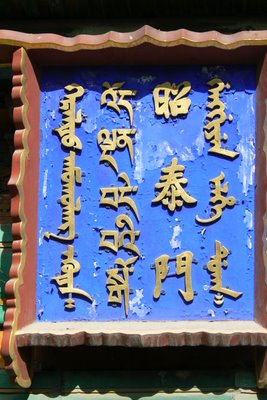
Tibetan Buddhism has a lot of elements that distinguish it from Han Chinese stylized Mahayana Buddhism, and the temple had a different feel from most others I've been to - if not nearly so different from the Buddhist temples I've seen in Japan, Thailand, or the US. The temple had fallen into disuse over the centuries, but was protected during the Cultural Revolution. It since been restored and is very popular with Han Chinese, I'm guessing mostly as a tourist attraction. There's a mini-industry of people selling incense outside, and people were buying them by the armload. The incense gets offered at points throughout. These areas get incredibly crowded with people bowing and burning incese, it looks like they're risking smoke inhalation!
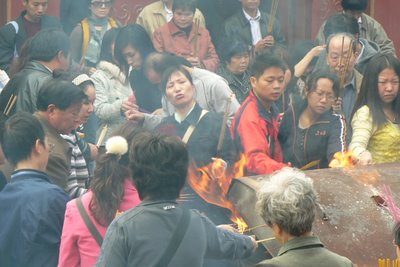
One of those boring things that I still get into, all across Asia, is the elaborate roofing. Notice the figurines on the corners, or the stupas, a feature common to Buddhist temples.
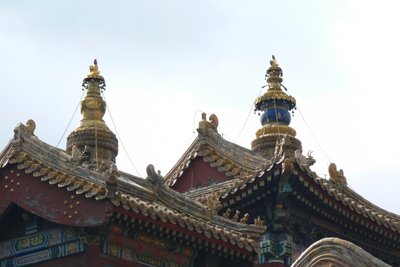
Interesting to note, this temple was originated as an expansion of a royal building, and in almost every regards, including size, layout, decoration, building design, etc., there was a strong parallel to what I had seen earlier, at the Forbidden Palace - this lion is half a step removed from the lion seen in my earlier look at Beijing.

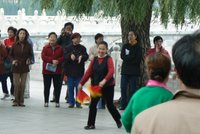 I should mention a couple things: first, I had a look at the parks to the Northwest of the Forbidden City, they were formerly a part of the Forbidden City compound. They were fun, with lots of people going there to practice dancing, or sing in groups, or play badminton, and so forth. If it seems silly, people are having fun, and that's what parks are for, right?
I should mention a couple things: first, I had a look at the parks to the Northwest of the Forbidden City, they were formerly a part of the Forbidden City compound. They were fun, with lots of people going there to practice dancing, or sing in groups, or play badminton, and so forth. If it seems silly, people are having fun, and that's what parks are for, right?These parks also featured a few hills, that provided looks over the Forbidden City, maybe they give a better glance at its scale:

And of course I went to a nearby section of the Great Wall, to have a look. One of the surprises (or at least, things I never had thought about before) was that the Great Wall is located on the top of a series of hills and mountains.
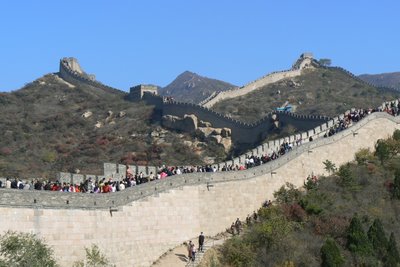
So naturally getting there, and getting around, involves a lot of climbing up steep (and as you can see, very crowded) terrain. Actually to get from the parking lot to the wall, they had a silly little cart and pulley system, it felt like when the roller coast starts out the ride by going uphill for a minute, except it was longer. A natural thought, upon seeing all of this, was what an insanely difficult job it must have been to construct a gigantic wall on what amounts to the worst possible terrain. It did offer amazing views, even if the sky was a little hazy:

The work isn't done - it requires constant upkeep, but hasn't been of military use for centuries. In the less tourist-acessible portions, the Great Wall has greatly deteriorated, often all the way into pebbles.
No comments:
Post a Comment